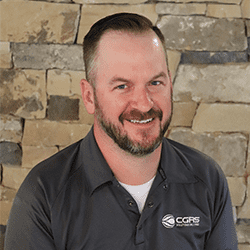Longmont paves Front Range RNG road for others to follow
Northern Colorado Clean Cities recently interviewed CGRS and City of Longmont, Colorado, representatives about the ins and outs of constructing a system that converts biogas at a wastewater treatment plant to Renewable Natural Gas (RNG). The goal: provide useful information about the decision-making and construction processes so other jurisdictions can determine if a similar project is right for their facilities and their communities. The following article is based on the content of those interviews.
Call a CGRS Expert:
800.288.2657

Cory Kahler
Water/Wastewater
Operations Manager
Mobile: 720.537.9387
Like any major capital improvement project, incorporating a renewable natural gas (RNG) system into your wastewater treatment plant (WWTP) operations takes research, planning and financial resources. It’s also critical to set sustainability goals and have a firm commitment to meeting them.
When the opportunity to build the Biogas Treatment and Renewable Natural Gas Fueling Station Project at the City of Longmont’s Wastewater Treatment Plant (WWTP) arose three years ago, officials had everything in place to start the process. It started with the City’s sustainability plan.
“Once we started thinking with a sustainable mindset, that helped frame how we made decisions and how we prioritized funding,” said John Gage, P.E., Public Works and Natural Resources Civil Engineer. “It started with considering sustainability in all facets of economic, environmental and social impacts to the community.”
From there, City officials looked at prioritizing long-term funding and spending, he said.
Gage oversaw the construction of the RNG project, which consists of a biogas cleaning system at the WWTP that converts biogas into RNG. The RNG is then piped to a new Waste Services facility on an adjacent property where it becomes Compressed Natural Gas (CNG) and is used to fuel the majority of the City’s Waste Services trucks.
City officials began looking at incorporating sustainable components into larger scale projects and budgeted a biogas project into a bond issue several years ago, he said.
Cory Kahler, CGRS Water/Wastewater Operations Manager and an expert in RNG/Compressed Natural Gas (CNG) systems, said like Longmont, many communities are setting sustainability goals and taking steps to meet them, such as replacing some of their petroleum or diesel-burning fleets with electric or CNG vehicles.
“It just makes sense that they take a gas that’s already being produced that they need to find something to do with and … not use as much diesel,” he said. “It’s a financial impact. The cost per gallon goes down pretty significantly when you start talking about not using diesel versus using RNG.”
With its system operating for more than six months now, Longmont is already realizing that impact, Kahler said.
Longmont city staff began researching biogas projects, visiting a number of sites, talking to other utilities, performing feasibility studies and then financial planning in 2016-17.
“The City of Grand Junction was very helpful,” Gage said. “They were the first closed-loop system, fueling trucks directly off of RNG.”
Kahler concurred that communicating with other jurisdictions that have completed successful RNG projects, including the cities of Grand Junction, Longmont and Boulder, and South Platte Valley Renew (formerly South Platte Water Renewal Partners), helps with making a decision.
“Reach out and talk to them, find out what the process has been like, what their experience has been like,” for accurate information and steps, he said. “We can only get better as we go and I think if you utilize someone who has gone through something like this, it will help tremendously. …
“I know that they’re all very proud of their systems. … They love to talk about them, they love to give advice on how to move forward with them.”
The design and construction of Longmont’s project began in 2018 and lasted into 2020, with commission and start-up in the spring. Other biogas projects often have shorter timelines from start to finish, Gage noted.
Kahler said in the course of planning its RNG project, Longmont officials determined that the trucks they were going to use in Waste Services could use most of the RNG. Their long-term goal was to add more trucks to their fleets that could use all of that gas instead of flaring it off.
“They store a significant amount of natural gas on-site in high-pressure vessels and then when they fuel their trucks, it comes out of those high-pressure vessels,” he said.
Before the completion of its biogas project, the City of Longmont’s WTTP did what most do: flared off the majority of the biogas that anaerobic digestion creates, using only a small portion of the gas to heat the digestion process, Gage said. WWTPs with anaerobic digesters flaring off their biogas are candidates for a RNG system.
Kahler noted that if the WWTP does not have an anaerobic digester that captures the methane gas, adding one onto an existing plant requires “a lot of construction. It’s an upgrade for a WWTP to do anaerobic digestion.”
If it already has an anaerobic digester, Gage said, “the first step would be to sample that biogas and send it out for analysis, making sure that it falls within the general standard of anaerobic digestion biogas statistics: 60% methane, 40% CO2 type of gas with some other trace contaminates. And if you’re there, the other thing is your flow rate: how much biogas are you really producing? That (data) can inform you on what solutions might be available to you.”
A smaller WWTP may not have sufficient inflow to produce enough gas to justify the cost of a biogas system and may not be the best candidate for a biogas system compared with a larger WWTP, Kahler said.

